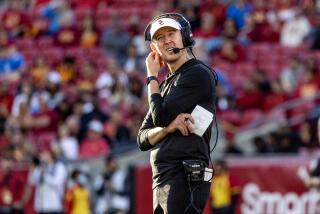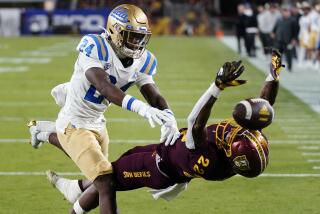Analysis : Peete, Playing to His Strength, Makes a Run at Aikman as Passer
- Share via
TEMPE, Ariz. — The thing that makes for much of the interest in next Saturday’s USC-UCLA game at Pasadena is that it will bring a rare late-season matchup of Heisman Trophy candidates who play their position, quarterback, in different ways.
This is the national perception:
--UCLA’s Troy Aikman is one of the finest passers in college football, perhaps the best of all.
--USC’s Rodney Peete is one of the better college football quarterbacks, perhaps the best in the country.
And the winner is . . . in the Rose Bowl on Jan. 2.
For most of the year, the perceptions have seemed to be generally correct. The classic passer has lost only once. The model passer-runner is still undefeated.
But against Cal last week, Peete made a run against Aikman as a passer, completing 22 of 29 attempts. And at Arizona State Saturday, he moved closer, throwing 2 40-yard bombs, throwing 3 scoring passes, and completing 23 of 33 for a personal-record 361 yards.
How is this happening?
The answer is that Peete is beginning to play to his strength.
He can throw on the run with more accuracy than most passers in either college or pro ball, and his coach, Larry Smith, has designed a rollout offense that led to most of the yards and points in a 50-0 rout here Saturday.
The ability to throw on the run is one of the game’s most uncommon. And more significantly, Peete has shown the talent to throw straight rolling either right or left.
What makes him do this so well?
“His vision is extraordinary,” Smith said. “That is what it takes.
“When Rodney moves, the field moves with him, and he sees it all.”
Football coaches and baseball managers alike pay a good deal of attention to the way teams match up against one another.
This leads to the thought that the Bruins’ best chance in this game may be that they match up well against USC.
Aikman is UCLA’s strength. Pass defense is USC’s weakness.
“It’s a concern, sure,” Smith said after the Arizona State game, declining to say any more than that about it.
What bothers USC’s defensive coaches is that although the Sun Devils were shut out this time, their passers and receivers found a lot of holes in the Trojan secondary.
Drops by Arizona State receivers and occasional wild throws by their sophomore quarterback, Paul Justin, tended to obscure the fact that USC wouldn’t have had this blank but for those lapses.
“You have to hold (the ball) to maintain any kind of drive,” said Arizona State Coach Larry Marmie.
Defensively, the Trojans have been a power this season, but good passing teams have made some yards against them. One opponent, Washington, nearly pulled an upset with long passes.
On the other hand, the Sun Devils were held to 61 yards rushing. They had to do something, and throwing the ball was their only option that worked.
The 50 points that Arizona State yielded Saturday added up to an aberration. For the most part, the Sun Devils have been a respectable football team this year--along with the others in the Pac-10.
Penn State may be having an off year. Ohio State has had some hard times. Texas hasn’t done much. In college football, it isn’t true that once a power, always a power.
But the Pac-10, by contrast, has shown unusual strength this year, top to bottom. Does USC’s Smith wish to explain it?
He’ll try.
“One explanation is that most Pac-10 teams are playing with returning starters at quarterback this season,” he said. “The key to a good year in college football is playing with a returning quarterback.”
Two examples are Peete and Aikman, who led their teams as juniors last season, but there are others on most Pac-10 campuses.
“Another factor was Arizona State’s win in the Rose Bowl two years ago,” Smith said. “I think that was instrumental in the rise of the Pac-10.
“It encouraged high school kids all over the West to tell themselves, ‘Hey, there’s a lot of teams around here we can play on.’
“As a result, the better Western athletes have been finding college homes somewhere--California, Arizona and on north.
“All 10 universities are getting the talent, and they all have solid coaching with strong programs. It’s become the best league in the country, and I think it will stay that way.”
More to Read
Go beyond the scoreboard
Get the latest on L.A.'s teams in the daily Sports Report newsletter.
You may occasionally receive promotional content from the Los Angeles Times.






